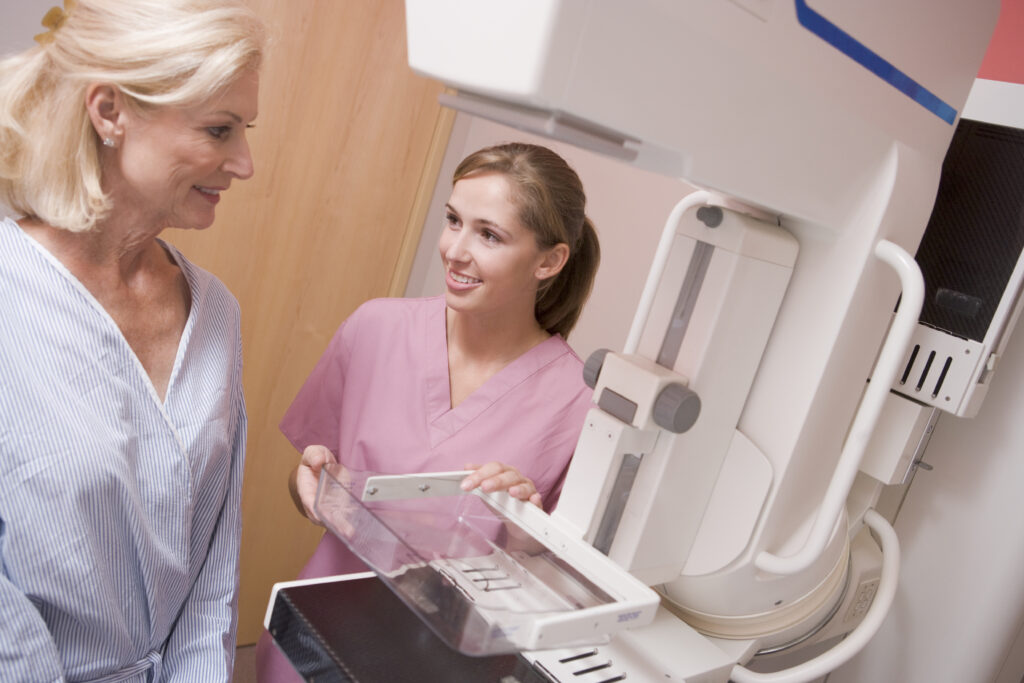A mammogram is a type of X-ray used to examine breast tissue for any signs of breast cancer. It is a crucial tool in the early detection and diagnosis of breast cancer, helping to improve your chances of successful treatment and recovery.
During the procedure, the mammography technician (mammographer) compresses the breast between two plates and takes an X-ray. The compression is necessary to spread out the breast tissue, making detecting any lumps or abnormalities easier.
Women aged between 50 and 70 are invited to have a mammogram every three years as part of the NHS Breast Screening Programme. However, women outside this age range who have a higher risk of breast cancer, such as those with a family history of the disease, may also seek screening.
If you want a mammogram before you are 50, you can book one with Echelon Health.
Some women have concerns and even anxiety about having a mammogram done — with the possibility of pain and discomfort or false-positive results the most common worries. However, the benefits of early detection and diagnosis of breast cancer far outweigh any temporary discomfort.
It is also vital to remember that most women who undergo mammograms will have a normal result.
Preparing for a mammogram
Before a mammogram, you must inform your healthcare provider of any breast symptoms, medical history or breast implants. You should also tell them if you are pregnant or breastfeeding, as mammograms are not recommended during these times.
It is also essential to avoid using any deodorants, talcum powder or creams on the day of the mammogram. These products can interfere with the accuracy of the results by creating shadows on the X-ray.
Wearing a separate top and bottoms (rather than a dress) can make you feel more comfortable, as you will need to remove your top during the procedure. Choose a top you can easily remove and put back on.
It is normal to feel anxious or worried about the mammogram procedure, especially if it is your first time. However, remember that mammograms are a routine procedure and necessary to detect and diagnose breast cancer at an early stage.
Feel free to discuss any concerns or fears with your healthcare provider, as they can give you answers and reassurance.
The mammogram procedure
During a mammogram, the mammographer will ask you to remove your clothes from the waist up and put on a hospital gown. They will position your breast between two plates, compressing them for a few seconds to flatten the breast tissue. This compression is necessary to get clear images and may cause mild discomfort or a squeezing sensation. The technician will take images of each breast from different angles.
The entire procedure usually takes around 20 minutes. The images will be sent to a radiologist who will analyse them.
Many women are concerned about the pain or discomfort associated with the procedure. The compression can cause mild discomfort but the procedure is generally not painful. If you are experiencing pain during the mammogram, inform the technician immediately.
Additionally, if you feel particularly uncomfortable about the procedure, you can request a female mammographer and ask for a gown to cover yourself.
Types of mammogram
There are two main types of mammogram procedures — screen-film mammography and digital mammography.
Screen-film mammography is the traditional method, using X-ray film to capture images. Digital mammography uses digital X-ray sensors to capture and store images to be viewed on a computer. Digital mammography is more accurate and can be better for younger women and women with dense breast tissue.
After the mammogram
After a mammogram, a radiologist will analyse the images and send a report to your doctor, who will tell you the results. The waiting time for results can vary, but it is usually within two weeks.
If your mammogram results are normal, your doctor will advise you to continue with regular mammograms, usually every two years. However, if the results show any abnormalities or the radiologist requires additional images, they will call you back for further tests or a follow-up appointment.
Remember that being called back for further tests does not necessarily mean you have breast cancer.
It is essential to continue with regular mammograms as they are most effective at detecting breast cancer early. Early detection is critical in treating breast cancer, and regular mammograms can increase the chances of successful treatment and survival.
Mammogram FAQs
Below we’ve covered some frequently asked questions about mammograms and what happens at them.
Does a mammogram hurt?
While a mammogram may cause some discomfort or mild pain, it is generally not painful.
How long does a mammogram take?
A mammogram usually takes around 20 minutes. However, the exact time can vary depending on various factors, such as the number of images required and your breast size.
What should I wear to a mammogram?
You will need to undress from the waist up, so it’s a good idea to wear a top and bottoms.
How often should I get a mammogram?
The recommended frequency for mammograms can vary depending on your age and risk factors. Generally, doctors advise women from 50-74 to have mammograms every two years. However, women with a higher risk of breast cancer may need to have them more frequently.
What happens if something abnormal is found on a mammogram?
If a mammogram detects an abnormality, you will be called back by your doctor for further tests or a follow-up appointment. The appointment may involve additional imaging tests, such as an ultrasound or MRI, or a biopsy, where a medical professional takes a small tissue sample for examination.
Can a mammogram detect all breast cancers?
Mammograms are highly effective at detecting breast cancer but they may not detect all cases. For example, dense breast tissue can make it more difficult to identify abnormalities in the images. Doctors may advise women with dense breast tissue to have additional imaging tests or more frequent mammograms.
What are the risks of having a mammogram?
The risks of having a mammogram are generally very low. The amount of radiation used during the procedure is minimal and not considered harmful. Additionally, there is a small risk of false positives, where an abnormality is detected but you do not have breast cancer.
Can I have a mammogram if I have breast implants?
Yes, you can still have a mammogram with breast implants. However, inform the technician before the procedure, as they may require special techniques to obtain accurate images. Women with breast implants may also need to have additional imaging tests, such as an ultrasound or MRI, to detect any abnormalities behind the implant.
Get in touch with Echelon Health
At Echelon Health, we put your health first. We offer various health assessments so you can take control of your health and prioritise early treatment. We provide a dedicated female health assessment package called the Cullinan Assessment, which includes a full-field digital mammogram.
The Cullinan Assessment is designed as a holistic experience. In addition to the highly detailed health assessment, our clients benefit from an overnight stay at The Mandarin Oriental Hyde Park, which includes a CBD oil deep relaxation massage and a chauffeur driven round trip transfer within 100 miles of our Harley Street clinic.
The following tests are part of the Cullinan Assessment:
- Comprehensive bloods + Hormonal Profile + cancer markers
- Digital mammogram
- Transvaginal Ultrasound
- ECG
- CT Coronary angiogram
- CT Chest
- CT Bone Density
- Full Body Mole Check
However, if you need more peace of mind, we have the fully comprehensive Platinum Assessment. Combining the best imaging technology through our CT, MRI and ultrasound scans and years of experience among our medical experts, Echelon Health are able to detect up to 92% and 95% of preventable causes of death among men and women respectively, in one comprehensive assessment.
Book your health assessment today with Echelon Health.
Sources:



